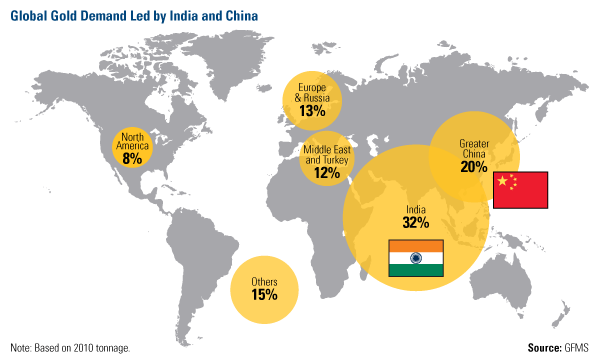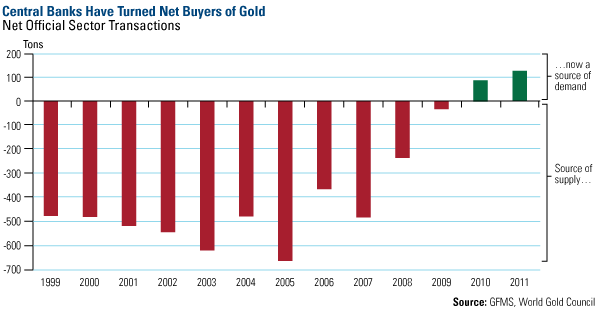In the East…gold is not only celebrated, acquired, worn or displayed during holidays or special occasions; it is seen as an everyday symbol of wealth. Increases in demand from China and India have driven a 7.5% increase in demand for gold jewelry during the first half of the year despite a 25% increase in the price. [Overall,] gold buying in India jumped 38% during the second quarter alone…China’s gold purchases jumped 90% on a year-over-year basis through June. In addition, demand from central banks is growing dramatically. [Such activity is setting up a] perfect storm – a tidal wave of gold demand [which can only keep prices high and escalating. Let me be more explicit.] Words: 959
as an everyday symbol of wealth. Increases in demand from China and India have driven a 7.5% increase in demand for gold jewelry during the first half of the year despite a 25% increase in the price. [Overall,] gold buying in India jumped 38% during the second quarter alone…China’s gold purchases jumped 90% on a year-over-year basis through June. In addition, demand from central banks is growing dramatically. [Such activity is setting up a] perfect storm – a tidal wave of gold demand [which can only keep prices high and escalating. Let me be more explicit.] Words: 959
So says Frank Holmes (www.usfunds.com) in an article* which Lorimer Wilson, editor of www.munKNEE.com (Your Key to Making Money!), has further edited ([ ]), abridged (…) and reformatted below for the sake of clarity and brevity to ensure a fast and easy read. The author’s views and conclusions are unaltered and no personal comments have been included to maintain the integrity of the original article. Please note that this paragraph must be included in any article re-posting to avoid copyright infringement.
Holmes goes on to say, in part:
Indian Demand Up 38% and Growing
Of the roughly 800 tons of gold imported to India each year, only the top 40 percent of Indian households purchase all of the country’s gold. The other 60 percent of Indians, who may have the same adoration for gold and celebrate Ramadan and Diwali, historically may not have had access to purchase gold. This large population represents a huge untapped market…[and it] is worth pursuing based on McKinsey’s research that a “huge wealth creation wave” is developing in India [and] “if purchase patterns continue, we will see from 2005 to 2025, a four times larger gold market in India.”
Chinese Demand Up 90% and Growing
India may be the world’s largest gold market, but in China, gold buying has become so significant that the country has become the fastest-growing market for gold jewelry in the world. Not only are Chinese purchasing increasing amounts of gold, they prefer pure 24-carat gold. This high-quality gold is given to celebrate special occasions, such as birthdays, and purchased for a bride at her wedding. In 2010, 6.6 million brides will make gold a part of their ritual as the yellow metal signifies the importance of a long-term relationship…
While jewelry represents a large percentage of gold purchases in the country, Chinese can also purchase gold at their local bank. WGC formed a partnership with the Industrial and Commercial Bank of China (ICBC Bank), the largest bank by deposits in the world. They began offering a “Gold Accumulation Plan” that lets investors buy and accumulate small portions of gold over time. Similar to a bank account, people participating have access to the underlying gold or the cash value at any point. Since it was launched in December 2010 through this summer, the ICBC has an estimated 1.7 million accounts, with an accumulation of more than 12,000 kilograms of gold.After India and China led the global demand for gold, accounting for 52 percent of 2010 tonnage, the GFMS says the two Asian countries have “continued impressive growth” this year. Gold buying in India jumped 38 percent during the second quarter alone…China’s gold purchases jumped 90 percent on a year-over-year basis through June. This is a follow up to the 75 percent increase in gold demand the country experienced last year.
North American Demand Down 12%
[As shown in the chart below] North America accounts for 8 percent [of global demand], Europe and Russia account for 13 percent, and the Middle East and Turkey together account for 12 percent. North American gold demand fell 12 percent during the first half of 2011 due to the slumping U.S. economy and rising prices.
Central Banks Have Become Net Buyers
Demand for gold isn’t only coming from the residents of China and India. There’s been a huge sentiment shift among central banks as well…[with] central banks have become net buyers of gold…[with] the vast majority of the buying coming from Eastern central banks [as can be seen in the graph below].
In just the first half of this year, official sector purchases are up three-fold over the 2010 total to 216 tons…The rise is largely due to low sales levels from Central Bank Gold Agreement (CBGA) signatories and the International Monetary Fund (IMF) completing its sales program at the end of 2010. In addition, other countries have gobbled up gold in an effort to diversify reserves away from the U.S. dollar. Scotia Capital estimates central banks’ total purchases of gold will reach 248 tons by year-end.
Some of the big buyers have been Mexico (whose central bank purchased roughly 100 tons of gold earlier this year), Korea (purchased 25 tons in June), Thailand (purchased nearly 19 tons in June) and Russia (which has purchased over 50 tons of gold from its domestic market year-to-date).
Eastern central banks are catching up with the rest of the world because their current allocation is tiny right now…[and] this could be just the beginning. Philip Klapwijk, Global Head of Metals Analytics at GFMS, said, “we are in essence in chapter three of the central bank story—we’ve left behind a period of heavy net sales, then a short period of neutrality and we’re now in a new environment of heavy buying.”
Listen to a Case for Investing in Gold
The above only scratches the surface of what was covered during a recent webcast. We discussed much more than China, India and central bank gold demand. If you missed it the first time, you can Listen to the webcast now. Find out the reasons we don’t believe gold is in a bubble, the economic factors affecting how gold is valued, and how our culture and emotions shape the gold-investing landscape. It’s great insight for the serious gold investor.
*http://www.usfunds.com/investor-resources/investor-alert/
Related Articles:
1. Asian Demand for Gold & Silver Will Cause Much Higher Prices – Here’s Why
Ignoring real estate, most people invest their hard earned money in paper things – stocks, bonds, annuities, insurance – [except] in China and India… [where] they are converting their hard earned paper money into gold and silver bullion. [While] that is nothing new the scale and speed with which they are accumulating precious metals IS new, and it’s driving the fundamentals that will lead to higher prices in 2011. Words: 1421
2. Goldrunner: a Gold & Silver Tsunami is Approaching – Fast!
A tsunami doesn’t start with a bang, but with a whimper. The first sign is a little hump in the water way out in the distance that is barely notable. Anyone who catches a glimpse of it simply continues to expect the day to be the same as the last many days – calm and beautiful waters along the shore. This is the point where we are, today in the Precious Metals sector. Many have seen the little roll of water out in the distance as Gold edged up in the first move of a more parabolic slope, yet most investors are mired in the same expectations of yesterday – a return for Gold to correct down into a lower base. Our analysis based on the fractal relationship to 1979 shows, however, that the mid 900s are a realistic target for the HUI by the end of the year or early in 2012; that $52 to $56 should be achievable for silver, with $58 to $62 as real possibilities; and that Gold should go the $2250 level followed by $2500 with the potential for $3,000, or a bit higher, now on the radar screen. Let me explain why that is the case. Words: 2130
100 of the 150 analysts who have gone public in maintaining that gold will eventually go to a parabolic peak price of at least $2,500/ozt.+ before the bubble bursts believe that gold will reach at least $5,000 per ozt. Take a look here at who is projecting what, by when. Words: 970
4. The REAL Reason Gold is Escalating in Price
When someone points to the Fed, the U.S. government and its “central planning” or “money printing” as the primary cause of the surge in the price of gold and justification of their USA hyperinflation theory, you might do them a favor and let them know that they’re right about the flaws of central planning and excessive money printing [but] that they’re focusing on the wrong central bank. [Let me explain why that is the case and who the real “culprit” is.] Words: 856
5. Here’s the Amount of Gold Bullion Held by Top 10 Countries
Here is an up-to-the-minute list of the amount of gold owned by the top 10 countries in the world plus that of the International Monetary Fund. Words: 257
7. Why are Central Banks Buying Gold?
Central banks have pulled 635 tonnes of gold – the largest withdrawal in more than a decade – from the Bank for International Settlements in the past year and, as such, begs the question: If central banks [supposedly] believe in the value of paper money and their ability to create wealth by printing it then why are they loading up on Gold? The answer is simple: they see the writing on the wall [and that begs an even more important question: Shouldn’t you?]…Words: 600 8. Why You Should Buy Physical Gold NOW!
Official figures released recently by the World Gold Council have confirmed that the annual demand for gold in 2010 rose by 9%, a ten year high, suggesting that the current price is not only sustainable but likely to increase further. Indeed, if you want to protect what you have and want to be sure that you are left with something for your future survival then get into gold now. It is the inflation proof investment that is like fire insurance for your personal wealth. Exactly like fire insurance, do you think you should buy it before or after the event? Words: 702
 munKNEE.com Your Key to Making Money
munKNEE.com Your Key to Making Money

